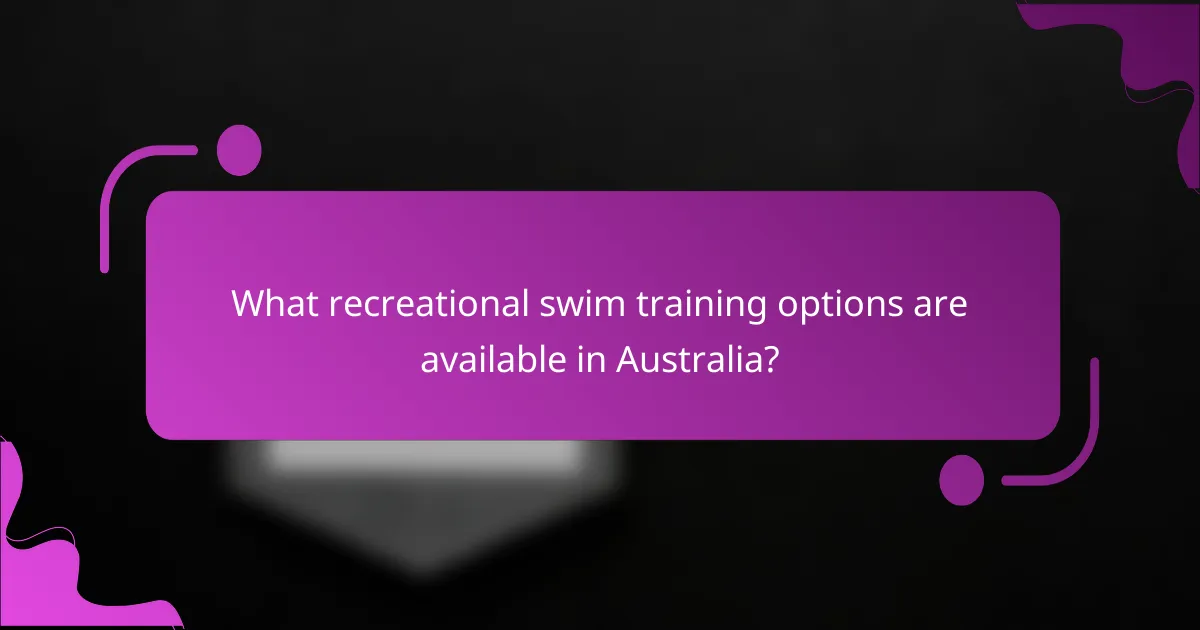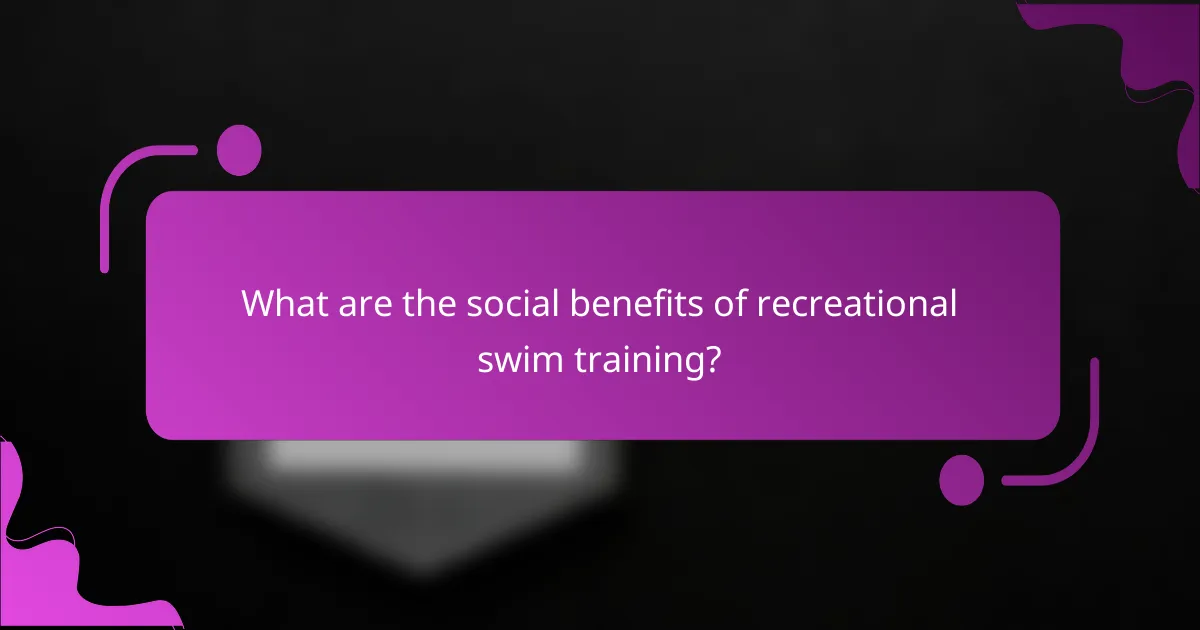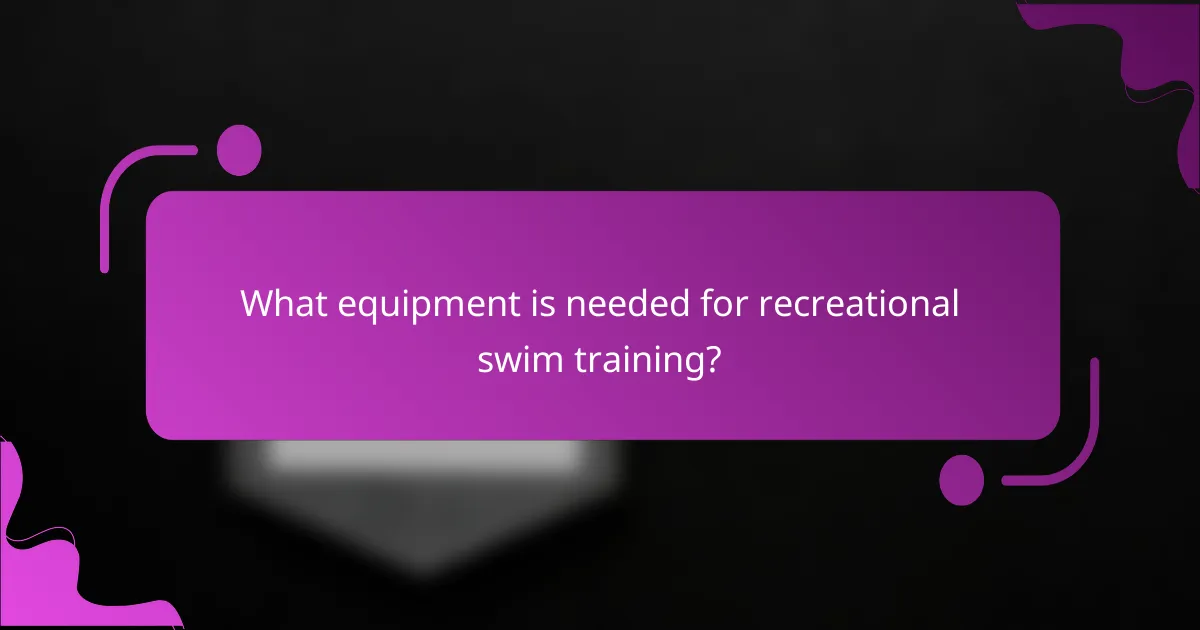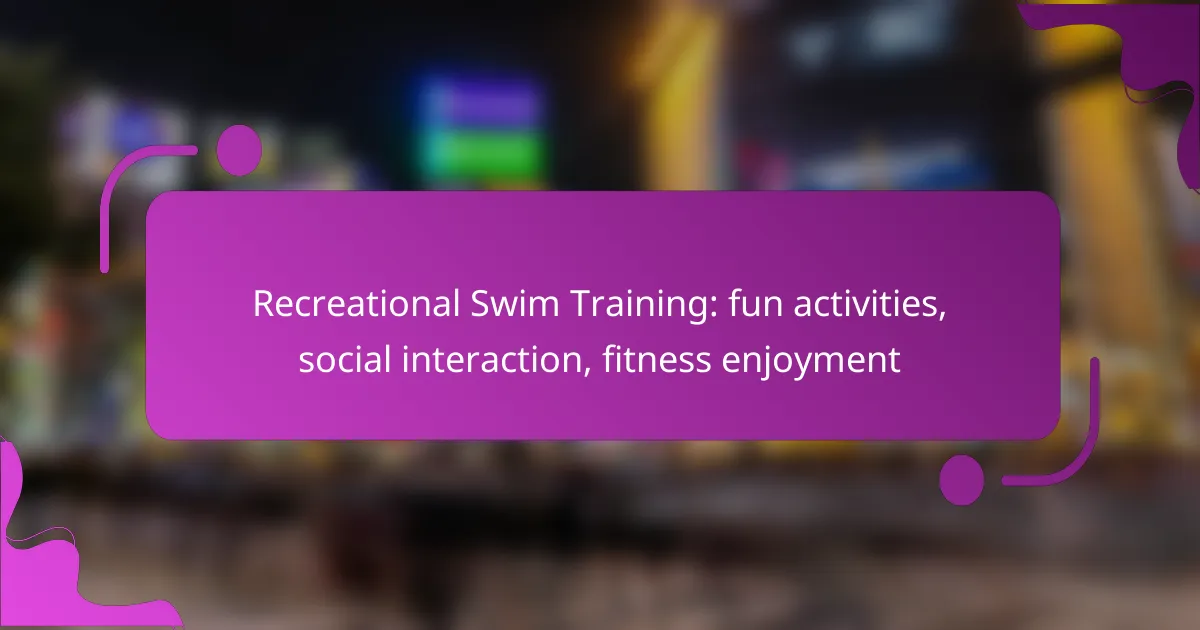Recreational swim training in Australia provides a variety of engaging options, such as group classes and family swim days, that cater to diverse preferences and skill levels. These activities not only promote physical fitness through enjoyable, low-impact workouts but also foster social interaction and community connections, making swimming a fun and enriching experience for all participants.

What recreational swim training options are available in Australia?
In Australia, various recreational swim training options cater to different preferences and skill levels. These include group swim classes, private lessons, swim clubs, water aerobics, and family swim days, each offering unique benefits for fitness, social interaction, and enjoyment.
Group swim classes
Group swim classes are a popular choice for individuals looking to improve their swimming skills in a social environment. Typically led by a qualified instructor, these classes accommodate various skill levels, from beginners to advanced swimmers. Participants can expect to engage in structured workouts that focus on technique, endurance, and fun.
When selecting a group class, consider the class size and the instructor’s qualifications. Smaller groups may offer more personalized attention, while larger classes can enhance social interaction. Classes are often available at local pools and community centers across Australia.
Private swim lessons
Private swim lessons provide tailored instruction for individuals seeking focused attention and personalized training. These lessons are ideal for those who may feel uncomfortable in a group setting or wish to accelerate their learning. Instructors can customize sessions to address specific goals, such as improving stroke technique or building confidence in the water.
Rates for private lessons can vary widely, typically ranging from AUD 50 to AUD 100 per hour, depending on the instructor’s experience and location. It’s advisable to check credentials and reviews to ensure a quality experience.
Swim clubs and teams
Joining a swim club or team offers a structured environment for those who enjoy competitive swimming or want to train regularly. Clubs often provide access to coaching, training sessions, and opportunities to participate in local competitions. This fosters a sense of community and encourages social interaction among members.
To find a swim club, check local community centers or swimming associations. Membership fees can vary, so inquire about costs and any required commitments before joining.
Water aerobics sessions
Water aerobics sessions combine fitness and fun, making them an excellent option for individuals of all ages. These classes typically involve low-impact exercises performed in shallow water, promoting cardiovascular fitness and muscle strength while minimizing joint strain. They are particularly beneficial for older adults or those recovering from injuries.
Classes are often available at local pools and are usually led by certified instructors. Participants should wear appropriate swimwear and consider bringing water shoes for added comfort and safety.
Family swim days
Family swim days are designed for families to enjoy recreational swimming together in a relaxed atmosphere. Many community pools host special events where families can swim, play games, and participate in activities. These events encourage bonding and promote a healthy lifestyle for all ages.
Check local pool schedules for family swim days, as they may occur weekly or monthly. Some facilities may offer discounted rates for families, making it an affordable option for quality time together.

How does recreational swim training enhance fitness?
Recreational swim training significantly enhances fitness by providing a low-impact, full-body workout that engages multiple muscle groups while promoting cardiovascular health. This enjoyable activity not only improves physical fitness but also fosters social interaction and mental well-being.
Improves cardiovascular health
Swimming is an excellent way to boost cardiovascular health as it elevates heart rate and increases blood circulation. Engaging in regular swim sessions can lead to improved endurance and reduced risk of heart disease.
To maximize cardiovascular benefits, aim for at least 150 minutes of moderate-intensity swimming each week. Incorporating interval training, such as alternating between fast and slow laps, can further enhance heart health.
Builds muscle strength
Recreational swimming effectively builds muscle strength by utilizing water resistance, which is greater than air resistance. This resistance helps tone and strengthen muscles throughout the body, particularly in the arms, legs, and core.
For balanced muscle development, incorporate various strokes such as freestyle, breaststroke, and backstroke. Each stroke targets different muscle groups, ensuring a comprehensive workout.
Enhances flexibility
Swimming promotes flexibility through the range of motion required for different strokes. The fluid movements involved in swimming help to stretch and lengthen muscles, which can improve overall flexibility over time.
To enhance flexibility further, consider incorporating stretching exercises before and after swimming sessions. Focus on dynamic stretches during warm-ups and static stretches post-swim to maximize benefits.
Promotes weight management
Recreational swim training can aid in weight management by burning calories effectively while being gentle on the joints. Depending on the intensity and duration, swimming can burn a significant number of calories, making it an efficient workout for weight control.
To support weight management goals, combine swimming with a balanced diet and regular exercise. Tracking swim sessions and caloric intake can help maintain accountability and progress.

What are the social benefits of recreational swim training?
Recreational swim training offers significant social benefits by fostering connections among participants, enhancing community bonds, and promoting teamwork. Engaging in swim activities not only improves fitness but also creates opportunities for social interaction and relationship building.
Fosters community engagement
Recreational swim training encourages community engagement by bringing together individuals from diverse backgrounds. Local pools often host swim classes, events, and competitions that invite participation from residents, creating a sense of belonging and shared purpose.
Community swim programs can also support local initiatives, such as fundraising events or awareness campaigns, further strengthening ties among participants. Joining a swim club or team can lead to regular interactions, enhancing the overall sense of community.
Encourages teamwork
Team-based swim training promotes collaboration and camaraderie among participants. Swimmers often work together to achieve common goals, such as improving technique or preparing for competitions, which fosters a spirit of teamwork.
Group training sessions can include relay races or synchronized swimming, where cooperation is essential. These activities not only build trust but also enhance communication skills, making teamwork a fundamental aspect of recreational swim training.
Builds friendships
Recreational swim training is an excellent way to build lasting friendships. Regular interactions during swim sessions create opportunities for socializing, leading to connections that extend beyond the pool.
Many swimmers find that participating in group activities, such as swim meets or social events, helps deepen these friendships. Sharing experiences, challenges, and successes in the water can forge strong bonds that contribute to a supportive social network.

What equipment is needed for recreational swim training?
To engage in recreational swim training, essential equipment includes swimwear, goggles, kickboards, fins, and swim caps. Each item plays a vital role in enhancing comfort, performance, and enjoyment during training sessions.
Swimwear and goggles
Choosing the right swimwear is crucial for comfort and mobility in the water. Opt for suits made from chlorine-resistant materials to ensure durability, and consider styles that fit snugly without restricting movement.
Goggles are equally important, as they protect your eyes from chlorine and improve visibility underwater. Look for goggles with adjustable straps and a comfortable seal to prevent leaks, ensuring a clear view during your swim.
Kickboards and fins
Kickboards are excellent tools for practicing kicking techniques and building leg strength. They allow swimmers to focus on their lower body while providing support, making them suitable for all skill levels.
Fins can enhance your training by increasing propulsion and helping you develop a stronger kick. When selecting fins, choose a size that fits comfortably and provides adequate support without causing strain.
Swim caps
Swim caps are essential for keeping hair out of your face and reducing drag in the water. They also help protect your hair from chlorine damage. Look for caps made from silicone or latex, as these materials offer a snug fit and durability.
When choosing a swim cap, consider your hair type and length. Longer hair may require a larger cap for full coverage, while shorter hair can often be accommodated by standard sizes.

What are the key considerations for choosing a swim training program?
When selecting a swim training program, consider factors such as your skill level, training goals, and the program’s structure. It’s essential to find a program that aligns with your fitness objectives while providing a supportive environment for improvement.
Instructor qualifications
Instructor qualifications are crucial when choosing a swim training program. Look for instructors who are certified by recognized organizations, such as the American Red Cross or the National Swim Coaches Association, as this indicates they have undergone proper training and adhere to safety standards.
Additionally, consider the instructor’s experience level. An instructor with several years of teaching experience can offer valuable insights and techniques that enhance your swimming skills. It’s also beneficial if the instructor has experience working with swimmers of your specific skill level, whether beginner, intermediate, or advanced.
Lastly, observe the instructor’s teaching style. A good instructor should be able to communicate effectively, provide constructive feedback, and create a positive learning atmosphere. You might also want to check reviews or testimonials from previous students to gauge their effectiveness.
